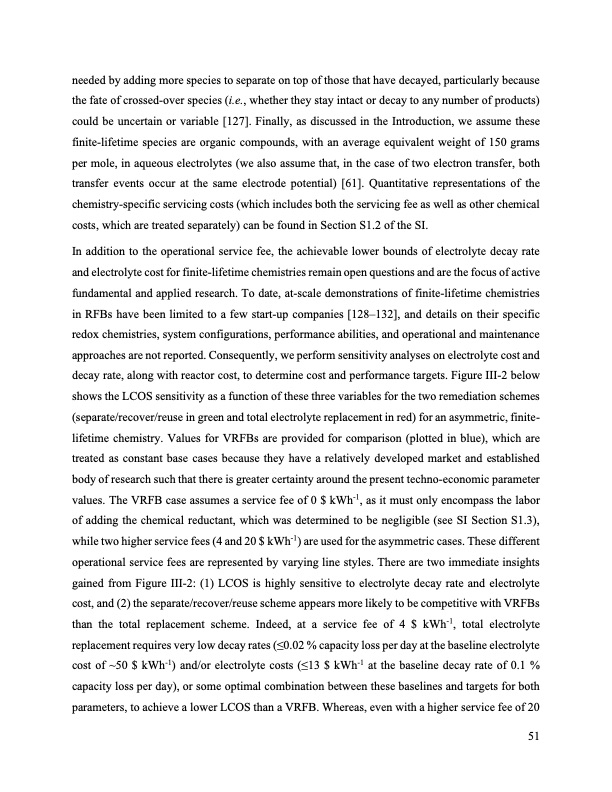
PDF Publication Title:
Text from PDF Page: 051
needed by adding more species to separate on top of those that have decayed, particularly because the fate of crossed-over species (i.e., whether they stay intact or decay to any number of products) could be uncertain or variable [127]. Finally, as discussed in the Introduction, we assume these finite-lifetime species are organic compounds, with an average equivalent weight of 150 grams per mole, in aqueous electrolytes (we also assume that, in the case of two electron transfer, both transfer events occur at the same electrode potential) [61]. Quantitative representations of the chemistry-specific servicing costs (which includes both the servicing fee as well as other chemical costs, which are treated separately) can be found in Section S1.2 of the SI. In addition to the operational service fee, the achievable lower bounds of electrolyte decay rate and electrolyte cost for finite-lifetime chemistries remain open questions and are the focus of active fundamental and applied research. To date, at-scale demonstrations of finite-lifetime chemistries in RFBs have been limited to a few start-up companies [128–132], and details on their specific redox chemistries, system configurations, performance abilities, and operational and maintenance approaches are not reported. Consequently, we perform sensitivity analyses on electrolyte cost and decay rate, along with reactor cost, to determine cost and performance targets. Figure III-2 below shows the LCOS sensitivity as a function of these three variables for the two remediation schemes (separate/recover/reuse in green and total electrolyte replacement in red) for an asymmetric, finite- lifetime chemistry. Values for VRFBs are provided for comparison (plotted in blue), which are treated as constant base cases because they have a relatively developed market and established body of research such that there is greater certainty around the present techno-economic parameter values. The VRFB case assumes a service fee of 0 $ kWh-1, as it must only encompass the labor of adding the chemical reductant, which was determined to be negligible (see SI Section S1.3), while two higher service fees (4 and 20 $ kWh-1) are used for the asymmetric cases. These different operational service fees are represented by varying line styles. There are two immediate insights gained from Figure III-2: (1) LCOS is highly sensitive to electrolyte decay rate and electrolyte cost, and (2) the separate/recover/reuse scheme appears more likely to be competitive with VRFBs than the total replacement scheme. Indeed, at a service fee of 4 $ kWh-1, total electrolyte replacement requires very low decay rates (≤0.02 % capacity loss per day at the baseline electrolyte cost of ~50 $ kWh-1) and/or electrolyte costs (≤13 $ kWh-1 at the baseline decay rate of 0.1 % capacity loss per day), or some optimal combination between these baselines and targets for both parameters, to achieve a lower LCOS than a VRFB. Whereas, even with a higher service fee of 20 51PDF Image | Bringing Redox Flow Batteries to the Grid

PDF Search Title:
Bringing Redox Flow Batteries to the GridOriginal File Name Searched:
Rodby-krodby-phd-chemE-2022-thesis.pdfDIY PDF Search: Google It | Yahoo | Bing
Salgenx Redox Flow Battery Technology: Salt water flow battery technology with low cost and great energy density that can be used for power storage and thermal storage. Let us de-risk your production using our license. Our aqueous flow battery is less cost than Tesla Megapack and available faster. Redox flow battery. No membrane needed like with Vanadium, or Bromine. Salgenx flow battery
| CONTACT TEL: 608-238-6001 Email: greg@salgenx.com | RSS | AMP |